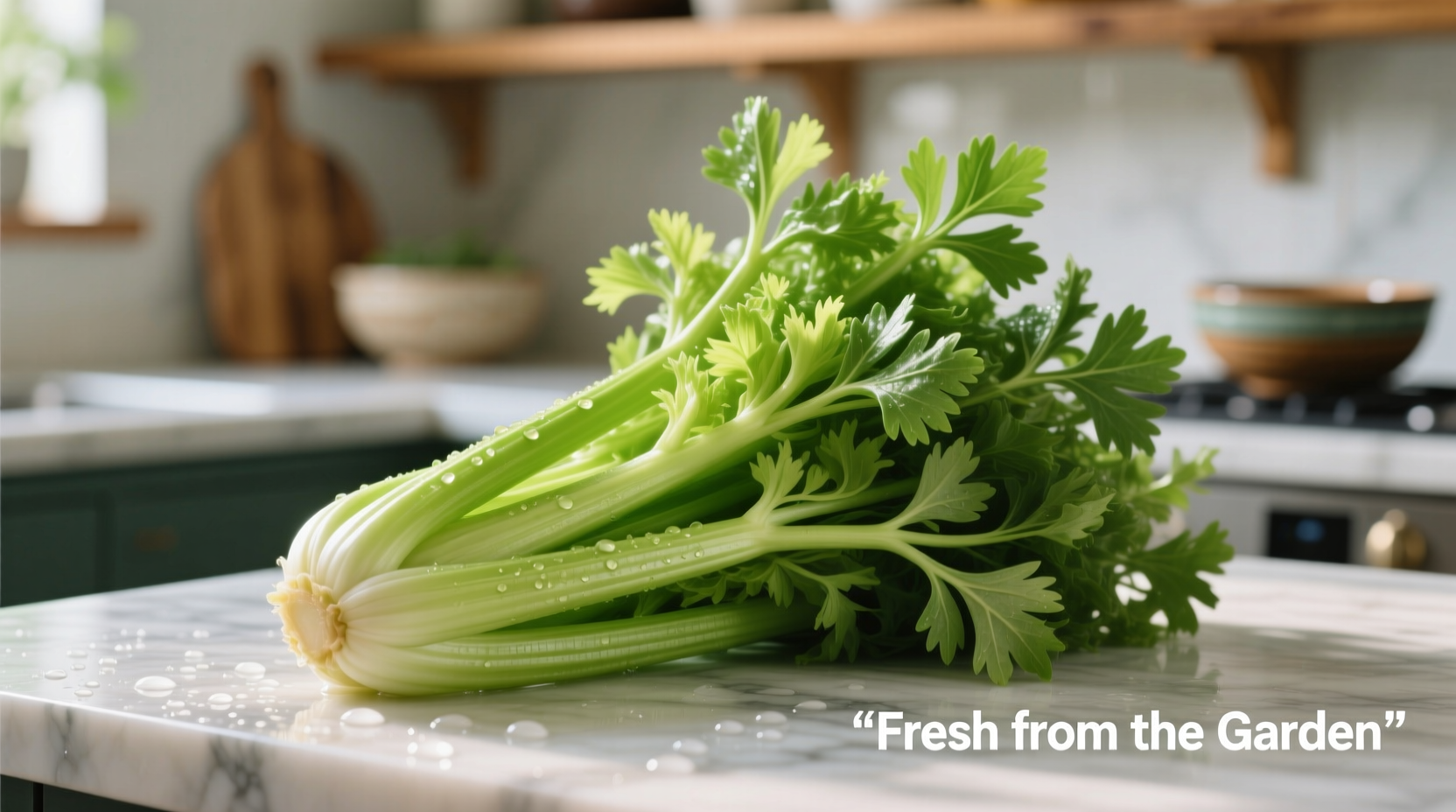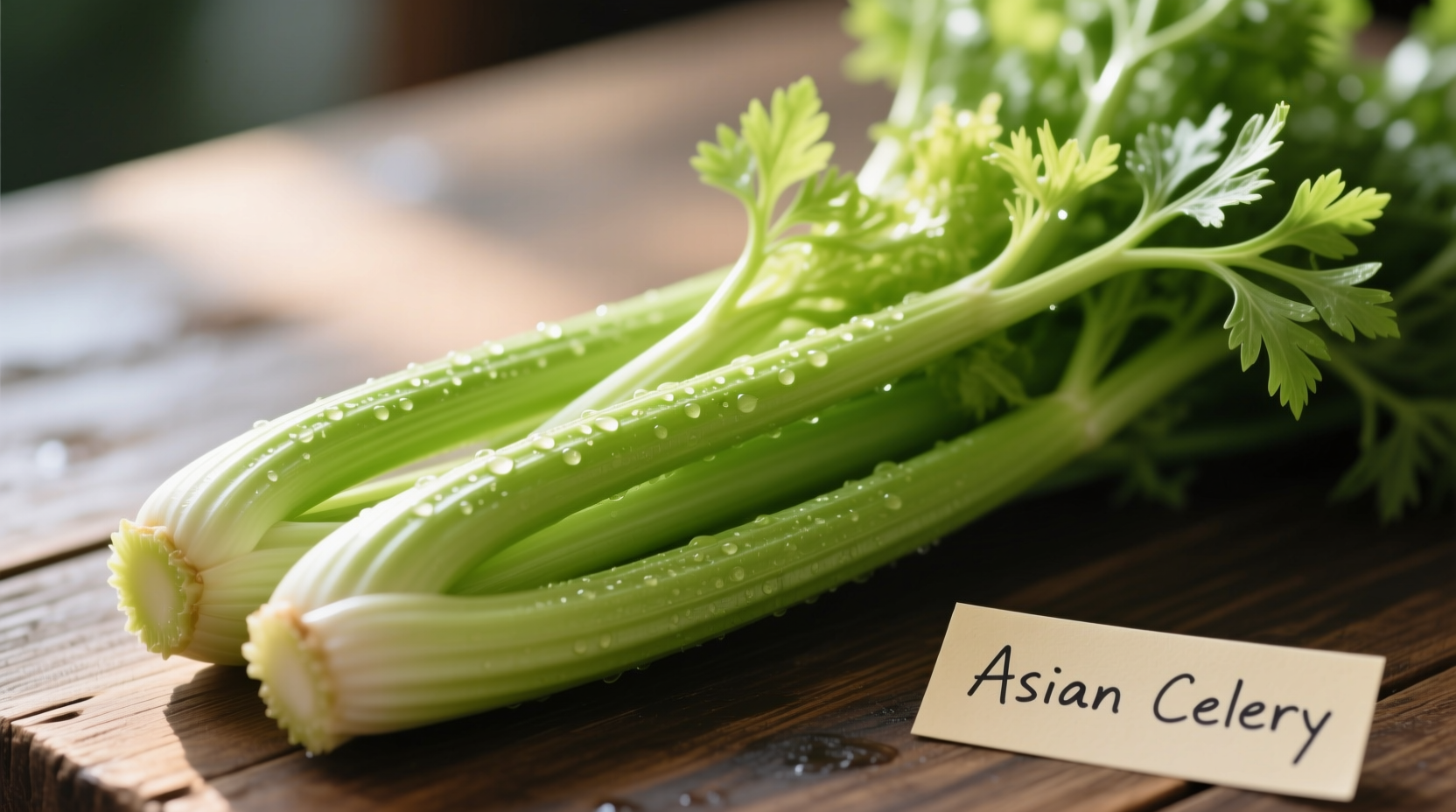Asian celery (Apium graveolens var. secalinum), also known as Chinese celery, is a thinner-stemmed, more intensely flavored variety with hollow stalks and a stronger aroma than its Western counterpart. It's essential in many Asian dishes, particularly Chinese stir-fries, soups, and braises, where its robust flavor holds up to high-heat cooking.
When you're exploring authentic Asian cooking, understanding the unique characteristics of Asian celery can transform your dishes from ordinary to extraordinary. Unlike the familiar Western variety found in most supermarkets, Asian celery brings a distinctive flavor profile that's fundamental to many traditional recipes across China, Vietnam, Thailand, and beyond.
What Exactly Is Asian Celery?
Asian celery, scientifically classified as Apium graveolens var. secalinum, represents one of the oldest cultivated varieties of celery. While Western celery (var. dulce) was developed for thicker, juicier stalks with milder flavor, Asian celery maintained its traditional characteristics through centuries of cultivation in East and Southeast Asia.
This variety features slender, hollow stalks that range from pale green to deep green, with a noticeably stronger aroma and more complex flavor profile than Western celery. The leaves are typically more abundant and delicate, often used as a garnish or flavor enhancer in many Asian dishes.
| Characteristic | Asian Celery | Western Celery |
|---|---|---|
| Stalk Thickness | Thin (¼ inch or less) | Thick (½ inch or more) |
| Stalk Structure | Hollow | Solid |
| Flavor Intensity | Strong, robust, herbal | Mild, subtle, slightly sweet |
| Texture When Cooked | Holds shape, remains slightly crisp | Becomes soft, sometimes mushy |
| Leaf Quantity | Abundant, delicate leaves | Fewer, tougher leaves |
Why Asian Celery Matters in Authentic Cooking
The distinctive flavor profile of Asian celery makes it irreplaceable in certain traditional dishes. Its robust herbal notes with subtle bitter undertones create the complex flavor foundations that characterize many Chinese and Southeast Asian cuisines.
According to research published by the USDA Agricultural Research Service, Asian celery contains higher concentrations of volatile compounds like limonene and β-phellandrene, which contribute to its more pronounced aroma and flavor compared to Western varieties. These compounds don't just affect taste—they also offer enhanced antioxidant properties.
Where Asian Celery Shines in Asian Cuisine
Asian celery isn't just a flavor component—it's often a structural element in traditional cooking techniques:
- Stir-fries: Added early in cooking to build flavor foundations, as its hollow structure absorbs sauces while maintaining texture
- Soups and broths: Used as an aromatic base similar to Western mirepoix, often combined with ginger and garlic
- Braises: Included in master stocks that develop complexity over multiple cooking cycles
- Raw applications: Finely sliced in salads and cold dishes, particularly in Vietnamese and Thai cuisine
- Medicinal preparations: Used in traditional Chinese medicine for its purported cooling properties
Chef Ken Hom, in his authoritative work Chinese Cooking (University of California Press), notes that "Asian celery's unique combination of texture and flavor makes it indispensable in authentic Cantonese cooking, where it forms part of the essential 'holy trinity' of aromatics alongside ginger and garlic."
Finding and Selecting Quality Asian Celery
Locating authentic Asian celery requires knowing where to look and what to select:
Where to find it:
- Asian grocery stores (labeled as Chinese celery, napa celery, or sometimes just "celery")
- Farmers' markets with Asian produce vendors
- Specialty produce sections in larger supermarkets
- Some online specialty produce retailers
What to look for:
- Bright green, crisp stalks without yellowing or wilting
- Abundant, fresh-looking leaves
- Thin stalks (typically no thicker than your pinky finger)
- Firm texture when gently squeezed
- Strong, pleasant herbal aroma

Proper Storage Techniques for Maximum Freshness
Asian celery has a shorter shelf life than its Western counterpart due to its thinner structure. To maximize freshness:
- Store upright in a container with 1-2 inches of water, like flowers, and cover loosely with a plastic bag
- Change water every 2-3 days to prevent bacterial growth
- Alternatively, wrap in slightly damp paper towels and store in a perforated plastic bag in the refrigerator
- Use within 5-7 days for optimal flavor and texture
- Freeze chopped celery in oil for cooking applications (not recommended for raw uses)
Substituting Asian Celery When Unavailable
While nothing perfectly replicates Asian celery's unique profile, these substitutions work in different contexts:
- For cooking applications: Combine Western celery with a small amount of celery seed and additional fresh parsley
- For soups and stocks: Use Western celery plus a few sprigs of fresh cilantro stems
- For raw applications: Try a combination of Western celery and water chestnuts for similar crunch
- For authentic flavor: Lovage leaves can provide a similar herbal intensity in small quantities
Remember that Western celery alone makes a poor substitute—it lacks the necessary flavor intensity and cooks down too quickly in high-heat applications.
Nutritional Benefits Backed by Research
Asian celery offers notable nutritional advantages over Western varieties. According to data from the USDA FoodData Central, 100g of Asian celery contains:
- 30% more vitamin K than Western celery
- Higher concentrations of polyacetylene compounds with anti-inflammatory properties
- Increased levels of phthalides, which may support cardiovascular health
- Rich in dietary fiber (2.5g per 100g)
- Low in calories (16 calories per 100g)
Traditional Chinese medicine practitioners have long valued Asian celery for its "cooling" properties and potential digestive benefits, though modern scientific research on these specific applications remains limited.
Mastering Cooking Techniques with Asian Celery
To get the most from Asian celery in your cooking:
- Preparation: Trim only the very bottom and any damaged outer stalks—most of the plant is edible
- Cutting technique: Slice on a diagonal for maximum surface area in stir-fries
- Cooking sequence: Add to hot oil first to release aromatic compounds before other ingredients
- Leaf usage: Don't discard the leaves—they contain concentrated flavor and make excellent garnishes
- Flavor pairing: Complements garlic, ginger, soy sauce, oyster sauce, and fermented black beans
When preparing classic dishes like Chinese celery and pork stir-fry, the timing of adding Asian celery is crucial—it should spend no more than 60-90 seconds in the wok to maintain its distinctive texture while absorbing flavors.
Common Questions About Asian Celery
Understanding these key points will help you work with Asian celery more effectively:
- Asian celery is not the same as celeriac (celery root)—they're different plant varieties
- The entire plant is edible, including the delicate leaves often discarded with Western celery
- It has a shorter shelf life than Western celery due to its thinner structure
- Its flavor intensifies when cooked, unlike Western celery which mellows
- It's a fundamental component in many traditional Chinese medicinal food preparations











 浙公网安备
33010002000092号
浙公网安备
33010002000092号 浙B2-20120091-4
浙B2-20120091-4